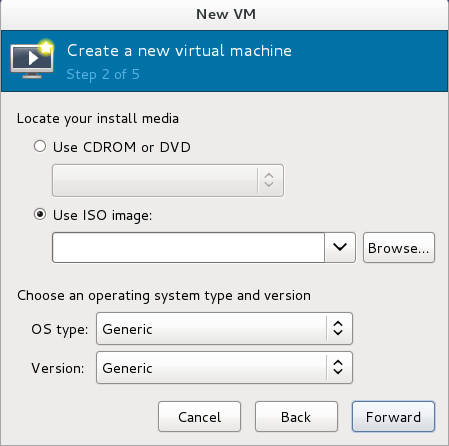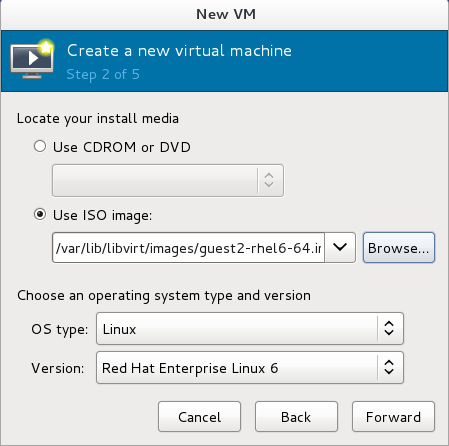Red Hat Training
A Red Hat training course is available for Red Hat Enterprise Linux
Chapter 7. Installing a Red Hat Enterprise Linux 6 Guest Virtual Machine on a Red Hat Enterprise Linux 6 Host
Note
7.1. Creating a Red Hat Enterprise Linux 6 Guest with Local Installation Media
Procedure 7.1. Creating a Red Hat Enterprise Linux 6 guest virtual machine with virt-manager
Optional: Preparation
Prepare the storage environment for the virtual machine. For more information on preparing storage, refer to the Red Hat Enterprise Linux 6 Virtualization Administration Guide.Important
Various storage types may be used for storing guest virtual machines. However, for a virtual machine to be able to use migration features the virtual machine must be created on networked storage.Red Hat Enterprise Linux 6 requires at least 1GB of storage space. However, Red Hat recommends at least 5GB of storage space for a Red Hat Enterprise Linux 6 installation and for the procedures in this guide.Open virt-manager and start the wizard
Open virt-manager by executing thevirt-managercommand as root or opening Applications → System Tools → Virtual Machine Manager.
Figure 7.1. The Virtual Machine Manager window
Click on the Create a new virtual machine button to start the new virtualized guest wizard.
Figure 7.2. The Create a new virtual machine button
The New VM window opens.Name the virtual machine
Virtual machine names can contain letters, numbers and the following characters: '_', '.' and '-'. Virtual machine names must be unique for migration and cannot consist only of numbers.Choose the Local install media (ISO image or CDROM) radio button.
Figure 7.3. The New VM window - Step 1
Click Forward to continue.Select the installation media
Select the appropriate radio button for your installation media.
Figure 7.4. Locate your install media
- If you wish to install from a CD-ROM or DVD, select the Use CDROM or DVD radio button, and select the appropriate disk drive from the drop-down list of drives available.
- If you wish to install from an ISO image, select Use ISO image, and then click the Browse... button to open the Locate media volume window.Select the installation image you wish to use, and click Choose Volume.If no images are displayed in the Locate media volume window, click on the Browse Local button to browse the host machine for the installation image or DVD drive containing the installation disk. Select the installation image or DVD drive containing the installation disk and click Open; the volume is selected for use and you are returned to the Create a new virtual machine wizard.
Important
For ISO image files and guest storage images, the recommended location to use is/var/lib/libvirt/images/. Any other location may require additional configuration by SELinux. Refer to the Red Hat Enterprise Linux 6 Virtualization Administration Guide for more details on configuring SELinux.
Select the operating system type and version which match the installation media you have selected.
Figure 7.5. The New VM window - Step 2
Click Forward to continue.Set RAM and virtual CPUs
Choose appropriate values for the virtual CPUs and RAM allocation. These values affect the host's and guest's performance. Memory and virtual CPUs can be overcommitted. For more information on overcommitting, refer to the Red Hat Enterprise Linux 6 Virtualization Administration Guide.Virtual machines require sufficient physical memory (RAM) to run efficiently and effectively. Red Hat supports a minimum of 512MB of RAM for a virtual machine. Red Hat recommends at least 1024MB of RAM for each logical core.Assign sufficient virtual CPUs for the virtual machine. If the virtual machine runs a multithreaded application, assign the number of virtual CPUs the guest virtual machine will require to run efficiently.You cannot assign more virtual CPUs than there are physical processors (or hyper-threads) available on the host system. The number of virtual CPUs available is noted in the Up to X available field.
Figure 7.6. The new VM window - Step 3
Click Forward to continue.Enable and assign storage
Enable and assign storage for the Red Hat Enterprise Linux 6 guest virtual machine. Assign at least 5GB for a desktop installation or at least 1GB for a minimal installation.Note
Live and offline migrations require virtual machines to be installed on shared network storage. For information on setting up shared storage for virtual machines, refer to the Red Hat Enterprise Linux Virtualization Administration Guide.With the default local storage
Select the Create a disk image on the computer's hard drive radio button to create a file-based image in the default storage pool, the/var/lib/libvirt/images/directory. Enter the size of the disk image to be created. If the Allocate entire disk now check box is selected, a disk image of the size specified will be created immediately. If not, the disk image will grow as it becomes filled.Note
Although the storage pool is a virtual container it is limited by two factors: maximum size allowed to it by qemu-kvm and the size of the disk on the host physical machine. Storage pools may not exceed the size of the disk on the host physical machine. The maximum sizes are as follows:- virtio-blk = 2^63 bytes or 8 Exabytes(using raw files or disk)
- Ext4 = ~ 16 TB (using 4 KB block size)
- XFS = ~8 Exabytes
- qcow2 and host file systems keep their own metadata and scalability should be evaluated/tuned when trying very large image sizes. Using raw disks means fewer layers that could affect scalability or max size.

Figure 7.7. The New VM window - Step 4
Click Forward to create a disk image on the local hard drive. Alternatively, select Select managed or other existing storage, then select Browse to configure managed storage.With a storage pool
If you selected Select managed or other existing storage in the previous step to use a storage pool and clicked Browse, the Locate or create storage volume window will appear.
Figure 7.8. The Locate or create storage volume window
- Select a storage pool from the Storage Pools list.
- Optional: Click on the New Volume button to create a new storage volume. The Add a Storage Volume screen will appear. Enter the name of the new storage volume.Choose a format option from the Format drop-down menu. Format options include raw, cow, qcow, qcow2, qed, vmdk, and vpc. Adjust other fields as desired.

Figure 7.9. The Add a Storage Volume window
Click Finish to continue.Verify and finish
Verify there were no errors made during the wizard and everything appears as expected.Select the Customize configuration before install check box to change the guest's storage or network devices, to use the paravirtualized drivers or to add additional devices.Click on theAdvanced optionsdown arrow to inspect and modify advanced options. For a standard Red Hat Enterprise Linux 6 installation, none of these options require modification.
Figure 7.10. The New VM window - local storage
Click Finish to continue into the Red Hat Enterprise Linux installation sequence. For more information on installing Red Hat Enterprise Linux 6 refer to the Red Hat Enterprise Linux 6 Installation Guide.

